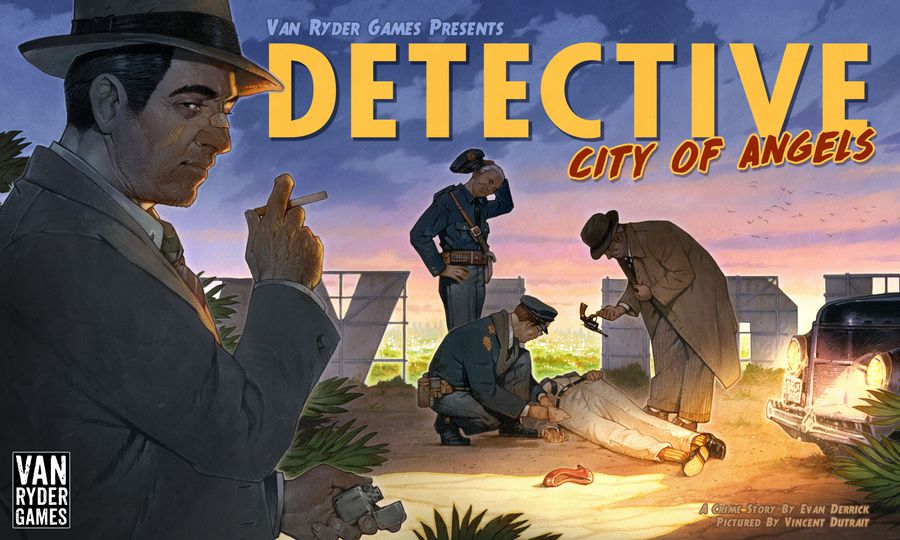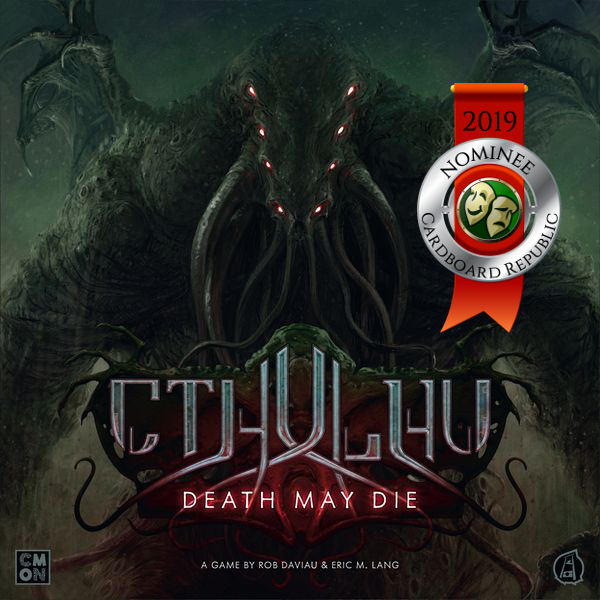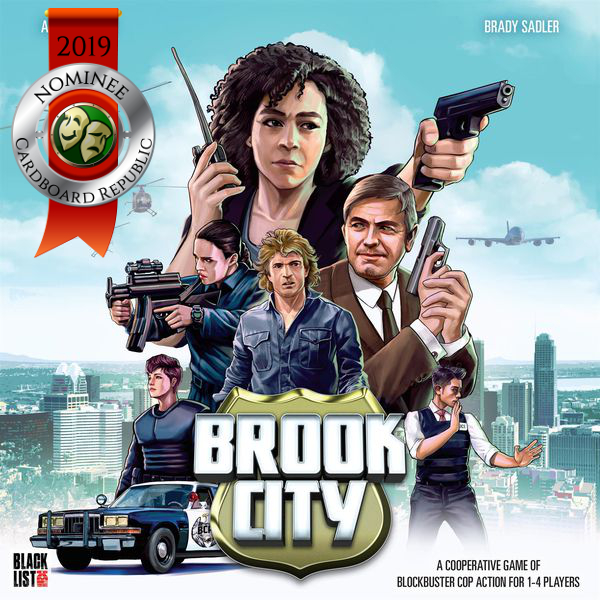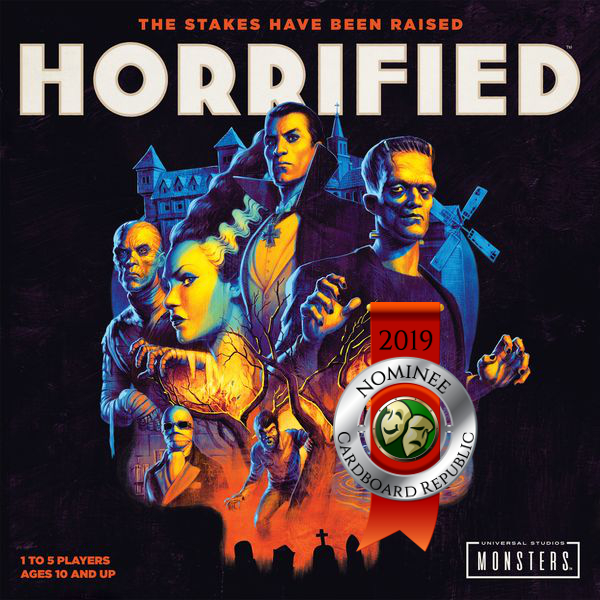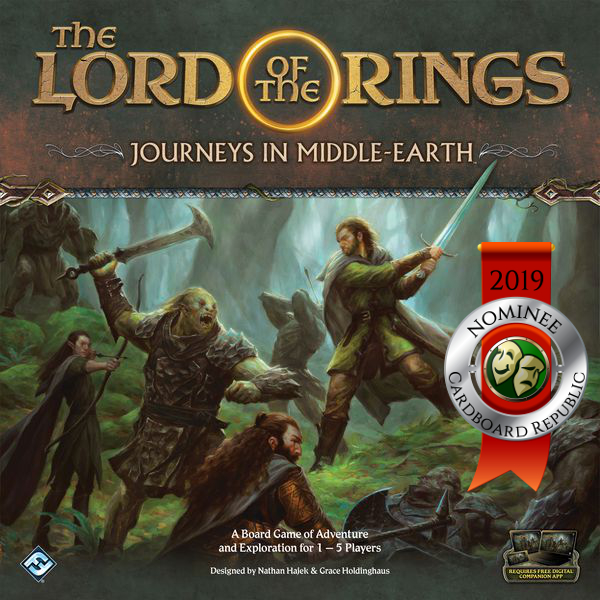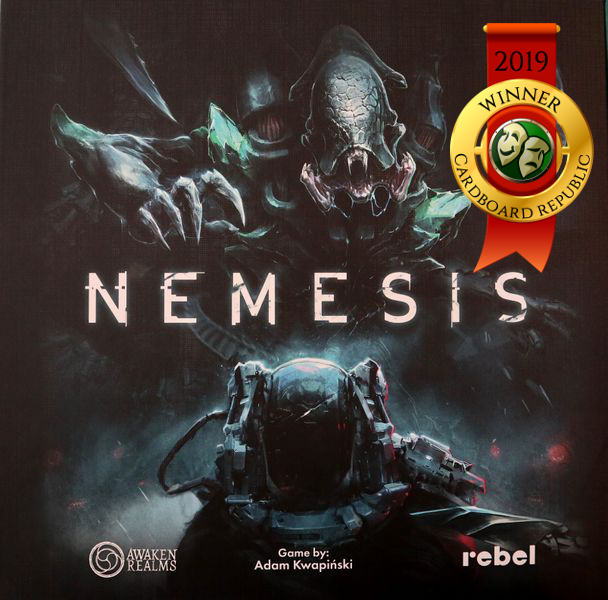The Cardboard Republic has rolled out the annual Laurels of the Republic awards, celebrating the best new games released in 2019 for each of the gamer archetypes. What follows are the finalists for one of those groups.
 From the depths of a cavernous dungeon, to the cold reaches of a distant conflict in outer space, to the exploration of the human condition, Immersionists thrive on a game’s locale. This group gets its biggest enjoyment out of games with rich settings that either tell some kind of story or serve some kind of purpose – games existing solely on basic mechanical or tactical choices are their kryptonite. Their driving interest revolves more around whether a particular mechanic or component fits whatever narrative is being told than if it’s the most ideal option. Immersionists want to be part of the game and feel as if their character belongs there. These roleplayers and worldbuilders demand that flavor actually matter to hold their interest – something more designers have been taking to heart in recent years.
From the depths of a cavernous dungeon, to the cold reaches of a distant conflict in outer space, to the exploration of the human condition, Immersionists thrive on a game’s locale. This group gets its biggest enjoyment out of games with rich settings that either tell some kind of story or serve some kind of purpose – games existing solely on basic mechanical or tactical choices are their kryptonite. Their driving interest revolves more around whether a particular mechanic or component fits whatever narrative is being told than if it’s the most ideal option. Immersionists want to be part of the game and feel as if their character belongs there. These roleplayers and worldbuilders demand that flavor actually matter to hold their interest – something more designers have been taking to heart in recent years.
And with that, here are The 2019 Laurel Finalists for Immersionists:
Honorable Mention: Detective: City of Angels
Publisher: Van Ryder Games | Players: 1-5 | Play Time: 30-150 Minutes
It’s difficult to truly encapsulate the hardnosed ambiance of noir in a game. These are crime dramas where right and wrong often aren’t clearly defined and the heroes themselves are tragically flawed in some way. Generating that kind of atmosphere without being able to dive inside the minds of the characters or seeing those conflicts play out visually has traditionally been a challenge. Luckily, that’s a challenge Detective: City of Angels has risen to meet.
Set against the dark and gritty noir of 1940s Los Angeles, Detective: City of Angels takes players on a ride through both the sprawling city and their character’s own questionable judgment. As one would expect, most of the players are LAPD flatfoots individually trying to chase down the department’s top cases of the day, and turns to that effect involve moving about the city, interviewing witnesses, inspecting locations, and gathering clues. The first player to solve the case is the winner.
Well, as much as there can be any winner in such a setting.
Actively working against all of them is another player as The Chisel. Rather than use standard flavor cards or a narrative call-and-response storybook approach for character interactions, The Chisel instead decides how to answer the detective’s questions on a character’s behalf. Maybe that character is telling the truth. Maybe they’re lying. Getting definitive answers in Detective are possible but costly, forcing sleuths to decide on their own how reliable the information they’re getting is. This approach taps wonderfully into the often blurry and ambiguous world of noir, where everyone seemingly has an angle, while also ensuring that each of the game’s cases never quite unfolds the same way. If the Chisel can sow enough doubt and misdirection, then they win instead while the rest go pound dirt.
As story-based games go, Detective is a real gas. Boasting an extensive array of decision trees and a unique asymmetric approach to its delivery, Detective offers a dynamic new spin on narrative gaming that’s tough for Immersionists to pass up. With era appropriate lingo, duplicitous witness testimony, and a ‘whatever it takes’ attitude, Detective does a dynamite job capturing the nuance, frustrations, and subdued demeanor that are so indicative to the genre but often missing in game form.
The Nominees

Number Five: Cthulhu: Death May Die
Publisher: CMON | Players: 1-5 | Play Time: 90-120 Minutes
Lovecraftian settings have become ubiquitous in board gaming, ranging from mere veneer used to spookify up a game to highly thematic forays into the sprawling and often muddled world of the author and his successors. The best Lovecraftian-inspired games are those which not only allow you to explore this universe in some fashion but also capture how even attempting to comprehend the wide array of cosmic horrors before you can drive the most stalwart defenders into madness. Now we can add Cthulhu: Death May Die to that list.
Cthulhu: DMD starts off with a familiar premise: each player is a circa 1920s investigator determined to put a stop to the influence of Cthulhu and his ilk once and for all. In this luck-filled cooperative setting, your team takes turns moving around the board, attacking enemies, investigating items, and enduring dreaded Mythos events.
However, unlike more benign Lovecraftian settings, where the focus is spent rallying the necessary goals and resources needed to prevent Cthulhu from entering our world, Death May Die takes a markedly different approach. Here you don’t want to stop the Elder Gods from showing up as much as you insist they do – so you can jam a broken beer bottle in their neck.
Hey, it’s not the most logical approach, but that’s probably because in this setting, everyone starts the game off already a little insane.
Yes, every game starts you off already in dire straits, adding immediate tension and purpose to the experience. The longer the game goes, the higher your madness level climbs. As a player’s insanity grows and the desperation of its characters becomes more evident, you gain more and more powerful actions to aid you. But it also means time grows ever more precariously short. And it is through this juxtaposition where Death May Die’s merit is at its highest.
With modular setups, intimidating miniatures, and a constant reminder that the window for victory is ephemeral at best Cthulhu: Death May Die encapsulates both the constant angst of its heroes and the terrible toll that winning will cost them – knowing full well the alternative is even worse. This is a dark playground that Immersionists will jump at…even if the prospect is at times a little maddening.
Number Four: Brook City
Publisher: Blacklist Games | Players: 1-4 | Play Time: 45-120 Minutes
No time to chat, boyo! There’s been another murder. So grab your gear, strap on your holster, and prepare to walk the bluest line you’ve seen.
That’s Brook City in a nutshell. In this highly flavorful Kickstarted co-op, players are a team of Brook City officers trying to thwart a sudden crime wave in their typically sleepy municipality. Fending off a syndicate of murderers, corrupt politicians, and cops on the take, it’s your job clean up the streets and solve the case. Boasting extensive variety between playable characters, suspects, and crime-riddled scenarios, playthroughs of the game follow similar turn-based patterns of moving, playing cards, and taking actions without succumbing to feeling dull or repetitive.
Which is fitting, as the game conjures up imagery of nearly every Hollywood action blockbuster in the last few decades.
No, really. Brook City is filled with more references from the last 40 years of cop movies and TV procedurals that it makes Hot Fuzz trite by comparison. From Fargo to Lethal Weapon, Robocop to Beverly Hills Cop, Police Squad to Brooklyn 99 (the list goes on and on), Brook City has more law enforcement callbacks than the New York City dispatch. The sheer volume of pop culture nods in the game is downright impressive, if even a little bewildering. Yet these constant nods to its inspiration only help accentuate the vibe of the game rather than detract from it. Never in all of this endless homage does it overshadow the actual gameplay.
Whether it’s a high octane chase through the city streets to disrupting a shady drug ring, Brook City offers a number of storyline elements to dive right into. Each cop brings different strengths with them to the force, and it’s up to the squad to work together and bring the bad guys to justice. All of which is backed up by some excellent production quality and a surprisingly accessible ruleset. Perhaps most telling of all, especially for Immersionists, is that this game doesn’t rely solely on nostalgic references to create a thematic experience. Instead, through its mix of variable setups, cohesive endgame objectives, and unpredictable dice-driven outcomes, Brook City epitomizes the notion of an emergent narrative that easily captures your attention, as well as inner imagination, from one playthrough to the next.
Number Three: Horrified
Publisher: Ravensburger | Players: 1-5 | Play Time: 60 Minutes
Let’s do the mash! The Horrified monster mash!
Horrified was a surprise hit of late summer 2019, with seemingly everyone walking away from the table enjoying the sensation of a Pandemic-esque exercise set against the backdrop of some of the most iconic cinematic monsters of the early 20th century. Its appeal took off like a mob of angry townsfolk and never really looked back.
In this ghoulishly entertaining lightweight co-op, players are citizens of a town that have suddenly been besieged by monsters. It is up to your group’s collective efforts to thwart their presence and save the town before it’s too late. Adding to that task are occasional townsfolk who will find themselves inextricably in harm’s way, forcing you to divert your attention from the main focus to escort them to safety and thereby making you juggle multiple goals at once.
Horrified brings back to the stage seven of the most classic silver screened monsters – the original cinematic shared universe – replete with iconic creatures such as Dracula, The Invisible Man, and The Mummy. Each monster operates with a set of unique traits, as well as its own unique conditions on how to defeat it. Every playthrough of Horrified uses a pair of these monsters, leading to a trio of obstacles to overcome: both the individual creatures themselves as well as the often vexing restrictions that befall the group as a result of them overlapping one another. But hey, no one expected monster eradication to be easy.
Well, unless you’re of the Van Helsing or Summers families.
Horrified is easily the lightest game of this list, with a hefty emphasis on pick-up-and-deliver as the chief mechanism to vanquish your foes. However, the degree to which it infuses overt flavor with that process, alongside the wonderfully appropriate means by which the monsters oppose your will, is more than enough to entice Immersionists several times over. Horrified is vibrant, engaging, replayable, and delightfully well-suited for an entire family of monster hunters. It also demonstrates with aplomb that, if done well, award-worthy thematic resonance can be accomplished irrespective of a game’s size or weight.
Number Two: The Lord of the Rings: Journeys in Middle-earth
Publisher: Fantasy Flight Games / Asmodee North America | Players: 1-5 | Play Time: 60-120 Minutes
Let’s get this out of the way first: yes, Journeys into Middle Earth is an app-driven game. While divisive to some, in its latest attempt Fantasy Flight appears to found the sweet spot between letting the app control the fiddly parts of a highly thematic adventure game without sacrificing the thrill of adventure, the lure of the unknown, and most importantly, the ability to shape the storytelling experience.
Building on the successful model of Mansions of Madness Second Edition (fittingly our 2016 Immersionist Honorable Mention), JiME further plumbs the depths of hybrid game design. Yet whereas Mansions was seen as a welcomed update to an existing title, this one has the latitude for a wholly unique venue.
You know, despite being Lord of the Rings and all.
Journeys isn’t the retelling of a titular Tolkien tale. Instead the narrative feels like a mix between events set outside the canonical stories and some finely hewed fanfiction. Each playthrough acts as a standalone adventure that players progress through as the game’s larger campaign-focused chronicle is slowly revealed. As one of the heroes – a mashup of some of the Fellowship’s most famous faces along with a pair of female characters wholly unique to this title – players work to accomplish the objectives tasked to them by their particular scenario. Turns in the game are remarkably simple, consisting of some combination of moving, attacking, and / or interacting with something in your space. Yet through this simple system lay copious material to encounter, places to explore, and foes to fend off. And whether you win or lose, the story advances all the same.
Much like the source material, the heart of the game resides with its characters. Embracing a group-based effort, every hero brings with them unique stats, abilities, skills, and an upgradable deck of cards used to resolve randomized encounters. The crux of the game’s appeal resides in melding those skillsets and watching those efforts refine over time. And it’s exactly that combination of guided storyline and emergent character narrative why Immersionists have fawned over this once since its release.
With that much thematic adulation and an innovative approach in doing so, Journeys in Middle Earth made an early run for this year’s top spot. But as it happens, another title came along and insistently clawed its way to the top…
The Winner
2019 Immersionist Laurel – Nemesis
Publisher: Awaken Realms / Rebel / Asmodee North America | Players: 1-5 | Play Time: 90-180 Minutes
When it comes to raw Kickstarter success, few publishers had a more banner 2019 than Awaken Realms. Known for their gritty, immersive settings and compelling (if slightly dark) narratives, this company has quickly made a name for itself by deftly stitching together one successful game after another. That, and the fact that nearly all of their games are chock full of impressive miniatures. 2019 alone saw them deliver on three multimillion dollar campaigns, including the long-awaited Nemesis.
Yet despite the fact that Nemesis handily delivers some of the most imposing xenomorph minis this side of LV-426, it’s almost ironic that from an immersive standpoint they may be one of the least noteworthy parts.
Which says something, because they are pretty cool.
In this semi co-op, each player is on a deathtrap of a ship en route back home. Roused from hypersleep and facing a growing alien infestation, each player spends their turns exploring new areas of the ship trying to attain supplies, weapons, and the special actions of the various rooms you reveal. All of this is pursuit of achieving your own secret objective – which may or may not be compatible with other players. In Nemesis trusting one another to survive is precarious…but it’s also absolutely essential.
At the heart of its acclaim are the aliens themselves. More specifically, the way Nemesis uses them to instill an ever-growing sense of dread and panic as the game unfolds. Attracted to movement, capable of leaping in and out of the shadows at nearly any turn, and able to potentially infect you with a scratch, a single encounter with one could be your last.
Between the game’s luck-based elements and its numerous checksum ways to lose, odds are quite high not everyone will make it out of this game alive. But if the engines work AND the ship stays on course AND it doesn’t blow up AND you don’t run out of time AND if you aren’t infected then MAYBE you’ll emerge victorious.
Maybe.
Numerous games have attempted and failed to properly capture the encroaching, foreboding sci-fi terror inherent to the Aliens franchise. Nemesis successfully does so in all but name. With extensive modular features, unpredictable outcomes at every turn, and championing an edge-of-your-seat experience so much so that, yes, the minis do almost become an afterthought, Nemesis delivers an anxiety-inducing challenge that’s positively bursting with narrative potential. And it precisely for those reasons why Nemesis has secured this group’s Laurel.
Also, on a side note…does this look infected to you?
![]()
Nemesis Contest!
We thought about different ways to highlight how great the winning title of the Immersionist Laurel is. We tried to come up with some clever and thematic ideas, such as creating a haunted house simulating the bowels of the ship, hosting an instructional video about how to avoid facehuggers, host an alien shapeshifter coloring book contest, or commandeering a Build-A-Bear store for a Construct Your Own Xenomorph workshop. But then we remembered that most of those things would require a lot of time, money, and according to our lawyers, open us to a litany of potential lawsuits that we simply don’t want to deal with this early into 2020 (like there isn’t enough going on already). So we’ve kept things tame on this one and opted for a simpler approach: providing one lucky winner with the opportunity to enjoy the award-winning game first hand.
That’s right! Enter below for your chance at your very own copy of Nemesis!
Note: In honor of their award recognition, Asmodee North America has kindly provided a copy of this game for giveaway purposes.
Additional Note: Due to the current circumstances around the coronavirus pandemic and supply chain disruptions, delivery of this title to the winner likely may be delayed by upwards of several weeks.
![]()
Be sure to check out the 2019 Laurel Award pages for the other archetypes once they go live!

